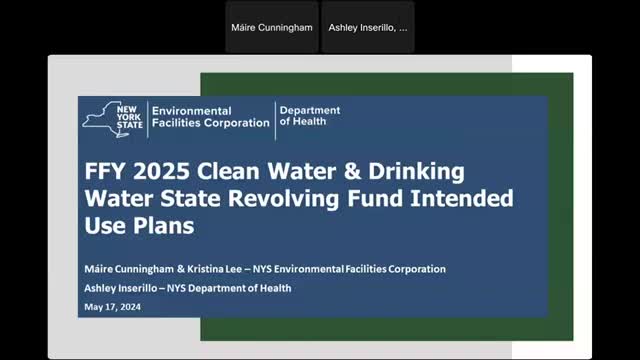State launches major funding initiative for clean water projects
June 03, 2024 | Environmental Facilities Corporation, State Agencies, Executive , New York

This article was created by AI summarizing key points discussed. AI makes mistakes, so for full details and context, please refer to the video of the full meeting. Please report any errors so we can fix them. Report an error »

In a recent webinar hosted by the Environmental Facilities Corporation (EFC), officials outlined the funding opportunities available for New York State's water infrastructure projects for the federal fiscal year 2025. The session, led by EFC Director Mara Cunningham, provided a comprehensive overview of the Clean Water and Drinking Water State Revolving Fund Intended Use Plans (IUPs).
Cunningham emphasized the critical role of EFC in financing water infrastructure, noting that since 1990, the state has invested over $45 billion in wastewater projects and approximately $9 billion in drinking water initiatives. The EFC administers various funding programs, including the Clean Water State Revolving Fund, which offers low-cost capital for sewer and wastewater treatment projects, and the Drinking Water State Revolving Fund, which supports drinking water projects.
Participants learned about the types of financial assistance available, including short-term financing for project design and construction, with terms of up to five years, and long-term financing options extending up to 30 years. Interest rates vary, with options for interest-free loans available to eligible applicants, making these funds a competitive choice for municipalities.
The webinar also highlighted specific grant programs, such as the Engineering Planning Grant Program and the Green Innovation Grant Program, which are aimed at clean water projects. The Water Infrastructure Improvement and Intermunicipal Grant Programs are currently open for applications, with a deadline set for June 14.
In addition to state funding, the EFC is administering federal funds from the Bipartisan Infrastructure Law (BIL), which is being allocated through the State Revolving Fund over a five-year period. This initiative aims to enhance the state's capacity to address water infrastructure needs effectively.
The meeting underscored the importance of these funding opportunities in ensuring safe drinking water and maintaining robust wastewater systems across New York State, while also addressing compliance issues and preventing future challenges in water management.
Cunningham emphasized the critical role of EFC in financing water infrastructure, noting that since 1990, the state has invested over $45 billion in wastewater projects and approximately $9 billion in drinking water initiatives. The EFC administers various funding programs, including the Clean Water State Revolving Fund, which offers low-cost capital for sewer and wastewater treatment projects, and the Drinking Water State Revolving Fund, which supports drinking water projects.
Participants learned about the types of financial assistance available, including short-term financing for project design and construction, with terms of up to five years, and long-term financing options extending up to 30 years. Interest rates vary, with options for interest-free loans available to eligible applicants, making these funds a competitive choice for municipalities.
The webinar also highlighted specific grant programs, such as the Engineering Planning Grant Program and the Green Innovation Grant Program, which are aimed at clean water projects. The Water Infrastructure Improvement and Intermunicipal Grant Programs are currently open for applications, with a deadline set for June 14.
In addition to state funding, the EFC is administering federal funds from the Bipartisan Infrastructure Law (BIL), which is being allocated through the State Revolving Fund over a five-year period. This initiative aims to enhance the state's capacity to address water infrastructure needs effectively.
The meeting underscored the importance of these funding opportunities in ensuring safe drinking water and maintaining robust wastewater systems across New York State, while also addressing compliance issues and preventing future challenges in water management.
View full meeting
This article is based on a recent meeting—watch the full video and explore the complete transcript for deeper insights into the discussion.
View full meeting
